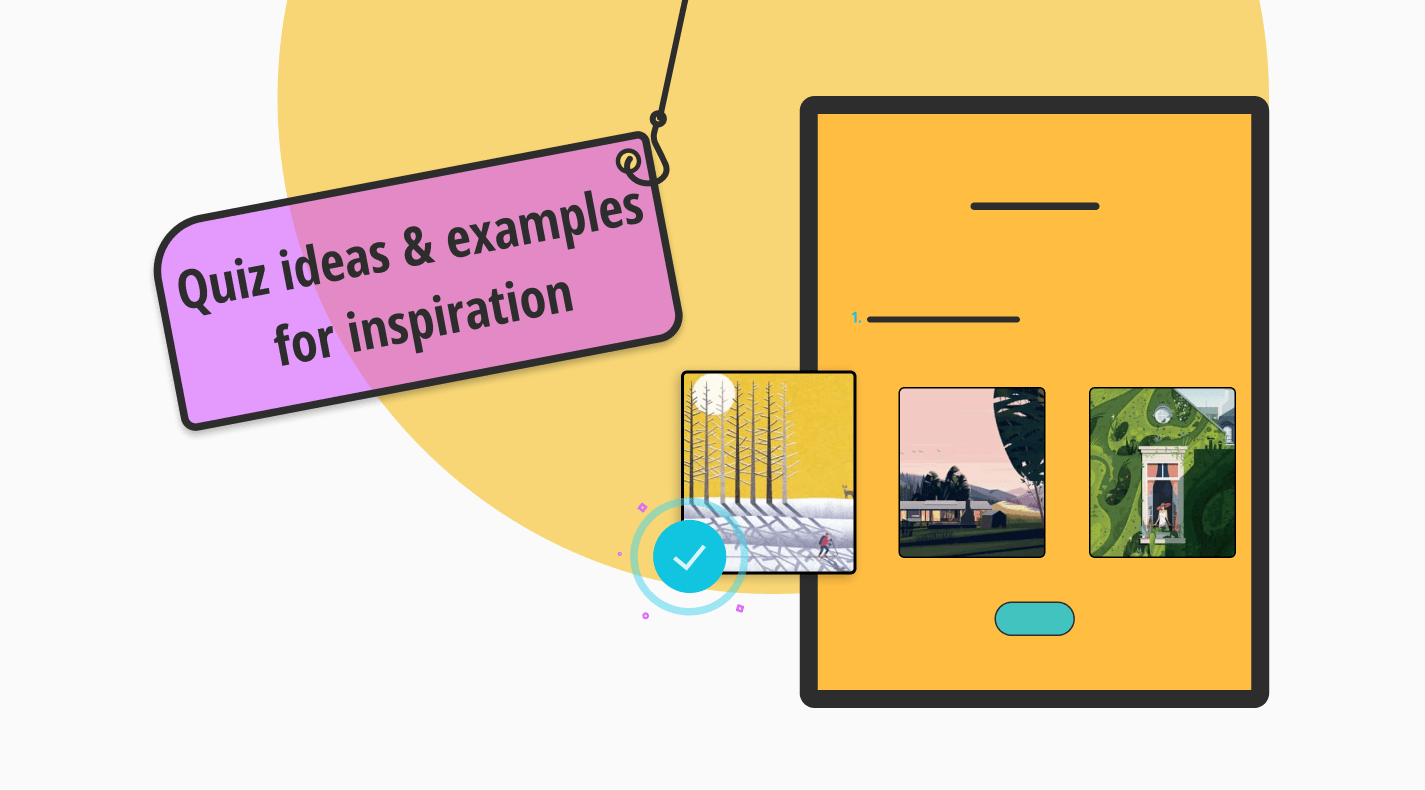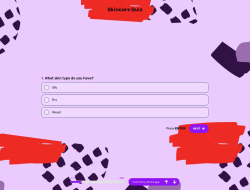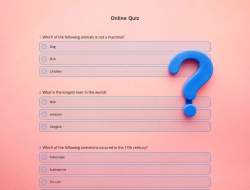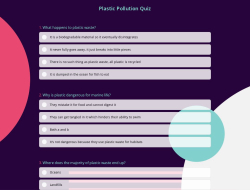Among the various lead generation tools you can create, the one that stands out as the most fun and versatile is the quiz.
Quizzes are great fun to take, can be great fun to make, and take a lot of the usual edge off from lead generation. People are put in a friendlier mood after taking one and will find it much easier to give you their personal information.
That is, of course, if you do a good job of making a quiz that ticks several important boxes. Let’s take a look at 13 quiz examples and help you get inspired to create your own.
The benefits of creating a quiz
Creating a lead generation quiz is a somewhat time-consuming affair, but the benefits you can expect are more than worth it. Utilizing quizzes can help you improve:
- audience engagement
- data collection
- social traffic and brand awareness
- revenue
- lead qualification
To achieve these goals, you will need to understand your audience well and create a quiz that is either useful or fun. If you are gating your content, you also need to ensure that the trade-off is worth it. What you offer needs to be valuable enough for a lead to give you their email address.
Types of lead generation quizzes
There are several types of lead generation quizzes you can utilize. Depending on your brand and the niche you operate in, you may be able to use all, or only some of them. Before choosing a quiz type, consider what your audience is most likely to enjoy, and which you would best be able to tie to your product or service.
- The personality quiz: along the lines of “Which Hogwarts House Do You Belong In” and “What Your Choice of Dog Breed Says About You.” They’re entertaining and people love taking them, as they’re meant to provide insight into their behavior and thought processes. If you are creating a personality quiz, make sure that answers actually make sense. You will need a deep understanding of the subject matter.
- The trivia quiz: quizzes like “Can You Name All the State Capitals” or, if you want to be more brand-specific, a quiz centered around your product/service and general niche.
- The knowledge quiz: needs to provide feedback after each answer and teach the quiz-taker something. The goal here is to share specific information with the quiz-taker.
- The product recommendation quiz: helps the quiz-taker determine which product they should choose, for example, “What Product is Missing In Your Skincare Routine.”
- The consultation quiz: in this instance, you would offer advice based on a certain input. For example, if you are a gas engineer, you can have a quiz like “What Does the Sound My Boiler is Making Mean.”
- The product personalization quiz: if your product can be personalized based on someone’s preferences or needs, this type of quiz works very well. Workout plans or meal plans are a great example, as they need to be tailored to the individual customer.
You can combine these different quiz types and create a completely unique experience for your visitors. Now, let’s dive into some examples and see which boxes you need to check when creating a unique, valuable, and effective quiz.
Idea #1: Use quiz results to personalize experiences
The quiz you produce needs to be directly tied to your offer. A “Which Hogwarts House Are You?” quiz may be a lot of fun, but unless you’re able to recommend a product on the back of it (maybe a makeup range?), it serves no real purpose.
Instead, aim to create a quiz that will help your leads select the best product for their own needs. This will improve user experience, ensure customers get the exact right product, and significantly improve your relationship with leads and shoppers.
Example #1
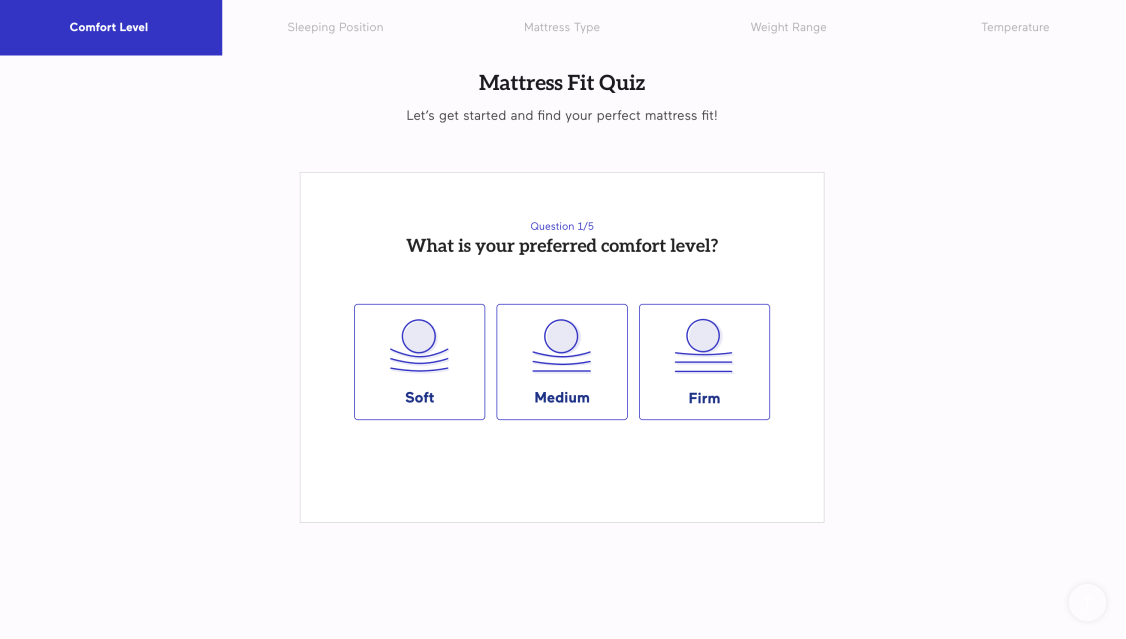
#1 Example
Take a look at Eachnight’s mattress selection quiz. It helps a visitor select the best product for their unique needs, and given the complexity of the product, this is a fantastic conversion path.
Most people are not likely to understand the difference between two very similar mattresses. So, the brand demonstrates how much they care about customer experience by creating a simple, short, but highly valuable quiz. It increases conversion rates and adds that important personalized touch to the shopping experience.
Idea #2: Use quiz results to personalize further communication
Creating a quiz and not using its results to improve your marketing efforts would be a complete waste of effort. Your quiz will tell you so much about each individual user, so make sure to utilize it for audience segmentation.
Once a lead has taken your quiz, use the data to send them personalized emails. Share information specifically for their needs, offer personalized product recommendations and discounts, and notify them when you get new products they might be interested in. This type of personalization is likely to boost the conversion rates of your email campaigns significantly.
Example #2

#2 Example
Let’s take the example of Murad’s skincare quiz. It helps them determine the skincare needs of each quiz taker, which then allows them to send a tailor-made newsletter for audience segments with different skincare needs.
If a customer also creates an account, the brand can go even further and suggest products while the shopper is browsing the website, saving them a lot of time and effort. Customers no longer need to see products that are not a match for their skin type, which keeps them focused and reduces choice paralysis.
(We also have a skincare quiz template for you!)
Idea #3: Use quiz results to personalize the product
Quizzes that help a user actually create a product are also incredibly beneficial, but naturally, they’ll only work for select brands. While both Murad and Eachnight (from our examples above) offer quizzes that help visitors select a product, some brands are able to take it a step further.
Example #3
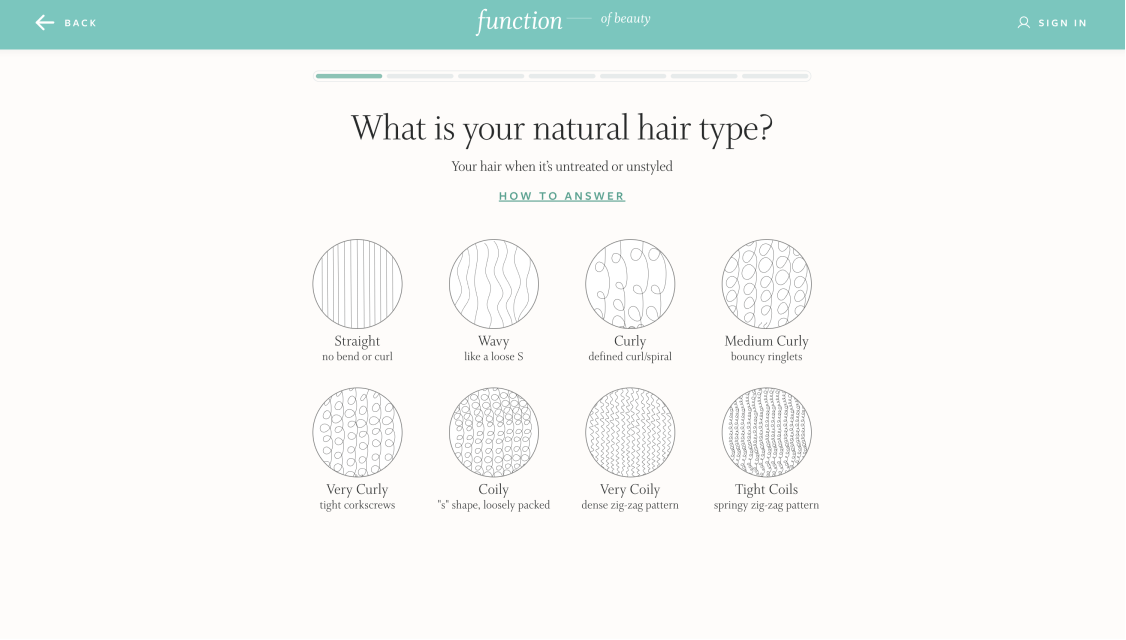
#3 Example
Case in point, Function of Beauty, which create their products based specifically on the needs of their customers. There is no stock, and each item is completely tailored to the individual.
The quiz here serves not as a lead generation tool but as a part of the shopping experience. If you are able to offer a similar option (perhaps in a limited quantity), you can expect to see engagement and conversion rates climb.
Idea #4: Help visitors learn something
Another great avenue to explore is offering a quiz that provides an answer to a specific dilemma your audience may have. This can work well for both ecommerce and service-based brands, as well as content-focused websites.
Essentially a knowledge-based quiz, it should also be entertaining and come with an enticing headline. You want people to click on it and remain engaged throughout.
Example #4
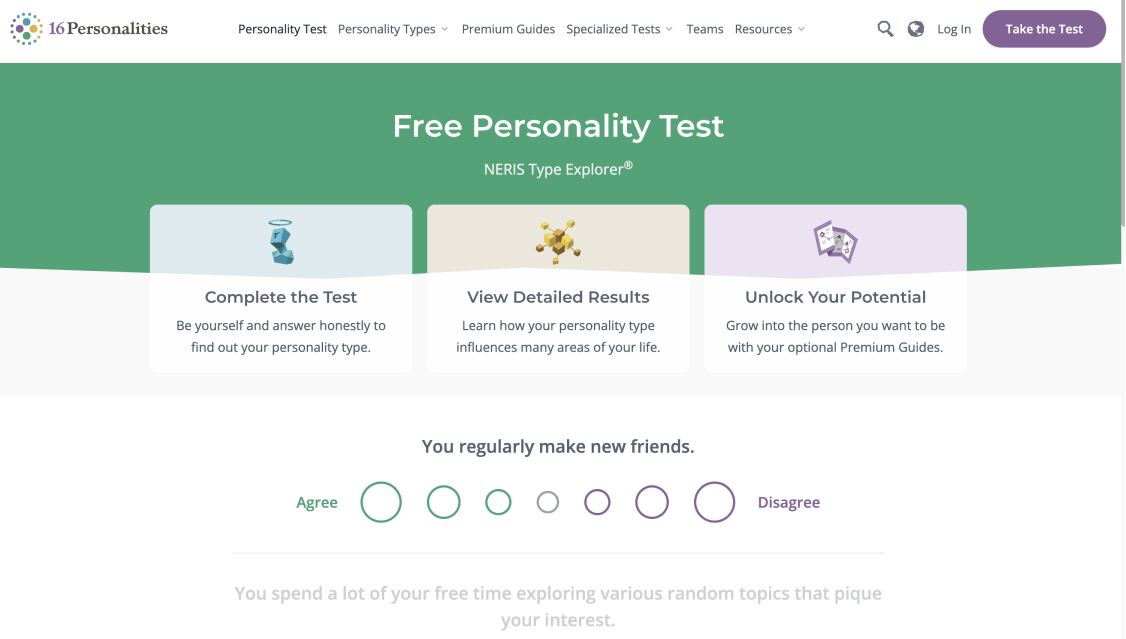
#4 Example
16 Personalities has based their entire business around a personality test, but their quiz serves as a great example. It helps quiz-takers understand themselves and the way their mind and emotions work.
While the quiz is quite long and will require 10-15 minutes to take, it then opens the door to the brand’s personalized newsletter, access to personality-specific content, and, more importantly, all the extra learning materials the brand sells.
For anyone looking to get to know themselves better, it’s a fantastic experience (and I personally highly recommend you take it, it’s incredibly insightful!).
Idea #5: Make the headline the hero
The headline of your quiz needs to be engaging, but it does not need to be overly flashy. As 80% of people only read a headline, the first impression you make will determine whether they take your quiz or not.
Don’t overthink this step, though. What the quiz is is what you need to tell your audience. Don’t go overboard with trying to be creative.
Example #5

#5 Example
For example, Neil Patel has a “Want More SEO Traffic” quiz. The headline is perfect and cuts right to the chase, ensuring that a large portion of the audience will actually click and see what they can get out of it.
Idea #6: Share the results anyway
One mistake a lot of brands make when building quizzes is insisting on the lead generation element. While it’s certainly a worthy goal, don’t sacrifice user experience for it. Let quiz-takers see the results even if they choose not to sign up to your newsletter.
This will reduce conversion rates but, at the same time, it will boost user experience. A lead who has had a pleasant experience with you is likely to come back. Somebody who has their time wasted on a quiz for which they can’t easily get results will be frustrated and unlikely to ever come back.
Example #6
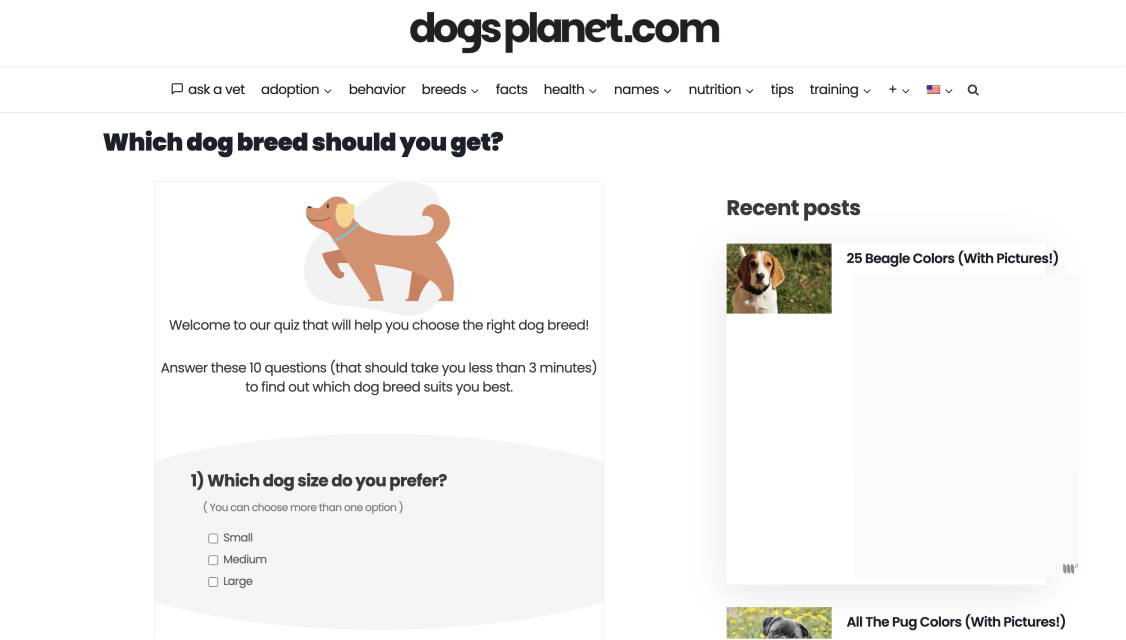
#6 Example
Dogs Planet has a dog breed quiz that has taken this into consideration and landed on the ideal solution. They let you choose if you want to sign up to the newsletter (and tell you what to expect), and they also let you see the results even if you have no interest in further contact with the brand.
Idea #7: Keep the results positive
No matter what the quiz is, make sure you never provide negative results. Even if it’s a trivia or knowledge quiz and someone gets all the answers wrong, you still want to sound positive and encouraging.
This is very important, as you don’t want to make anyone feel frustrated or bad about themselves. How likely are they to convert if you tell them they suck at something?
Example #7

#7 Example
Take a look at how Agatha Christie Limited has taken this task on. Even when you get a poor result on one of their quizzes, they find the silver lining and don’t make you feel bad about the blunder. You will need to employ your best copywriting skills here, as you aim never to alienate your audience.
Idea #8: Make it look good
Finally, you need to make sure the quiz looks good. It needs to hold a lead’s interest and keep them engaged, so design and layout will play an essential role.
If you can, use your own images to very obviously tie your products in with the quiz. Feature your brand’s colors, and make sure your voice is also felt throughout.
Example #8
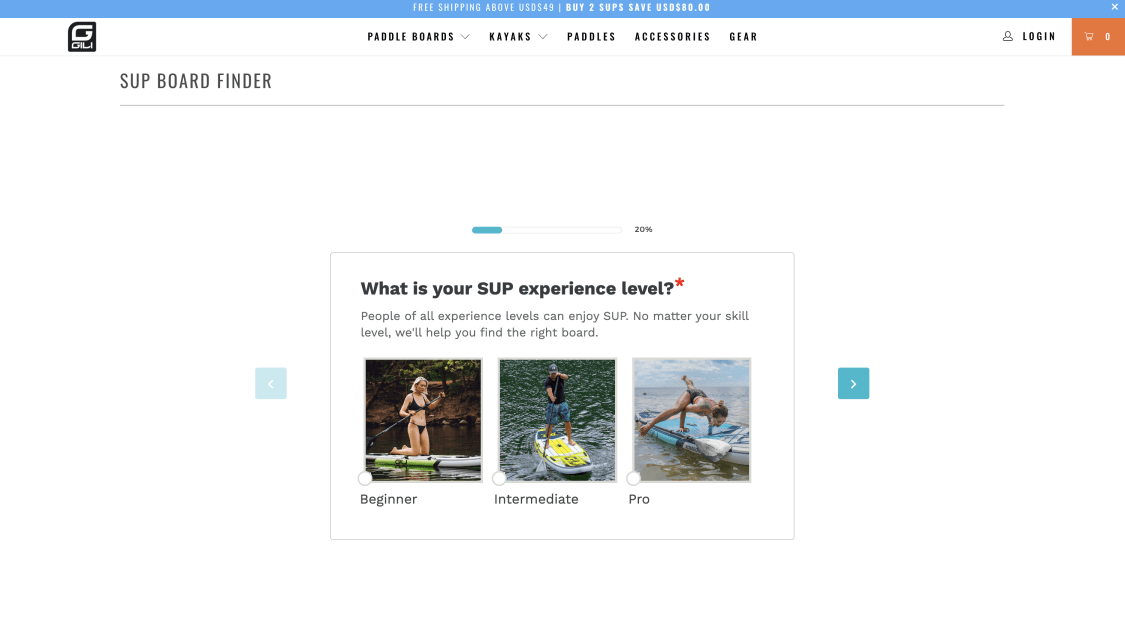
#8 Example
Apply⌘ + EnterRemoveLet’s look at Gili’s SUP board finder as our example. They use their own photos for the quiz, all of which make you want to head out to the water immediately. The quiz is short and to the point; there are no superfluous questions, and it’s enjoyable to take.
It’s not overly fancy, though. It’s simple to design something quite similar, which proves everyone can create a quiz, and you don’t need any extensive design experience to do it well.
5 More examples to inspire your next quiz
Now that we have the basics down, let’s take a look at five more quizzes and what they do well, so you can get started on your own. We’ve outlined their main features and the elements they have tackled best, so use each of them as inspiration for a certain aspect of quiz creation.
Note that your goal is not to copy them, merely to see how you can write great copy and design eye-catching layouts.
The NHS how are you quiz

#9 Example
The NHS has created a How Are You quiz that provides a quick health assessment to takers. While by no means a diagnostic tool, it’s a nice way to check in on your health and wellbeing.
What this quiz does right:
- Provides a lot of value
- Capitalizes on personalization
- Fun copywriting
- Actionable advice as a result
Most importantly, the quiz makes you feel heard, seen, and less alone. And while the NHS has no real conversion purposes, the quiz is a great example of the kind of copywriting you want to employ and the emotions you want to elicit.
The Virginia furniture market design style quiz
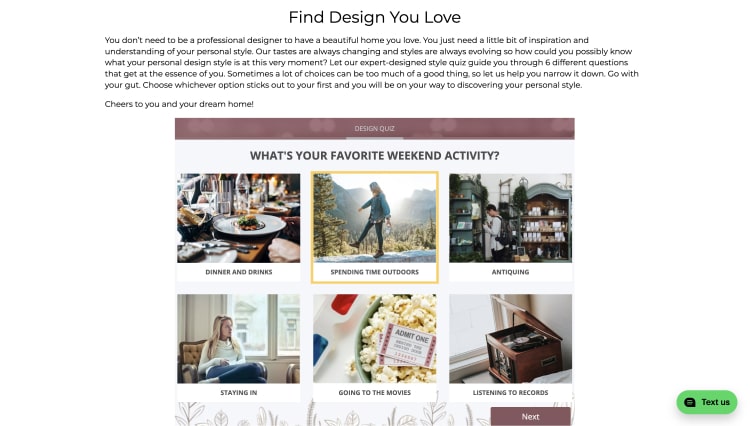
#10 Example
This design style quiz by the Virginia Furniture Market is a prime example of a quiz that does an amazing job of tying the brand’s products with the quiz results.
Here’s what it does right:
- Great use of imagery
- Personality-based questions that are easy to answer
- Promotional results that don’t focus on the sale but on the inspiration
The quiz provides an excellent opportunity to display the store’s products, but it does so in an unobtrusive way, and the sales element is not placed in the forefront.
Grammarly’s grammar troll quiz
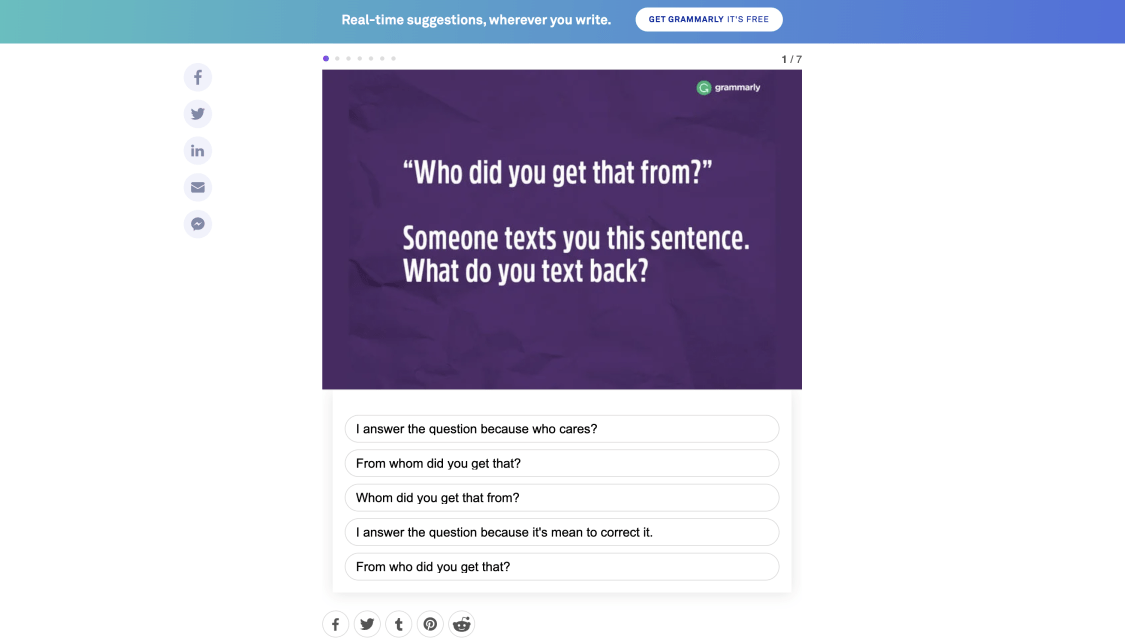
#11 Example
Grammarly is known for its aggressive marketing tactics (remember when it used to be every other ad on Youtube?). But you can’t deny that they are great at creating interesting content.
Their Grammar Troll quiz proves that, as it’s:
- It’s witty and pokes gentle fun at a specific personality type
- It makes the sales pitch easy to insert
- It is highly shareable on social media
This is the type of quiz that leads will love to share, but it’s also a great piece of content the brand can promote. For boosting social media engagement and follower counts, it’s a fantastic choice.
The Ben and Jerry’s which flavor are you quiz
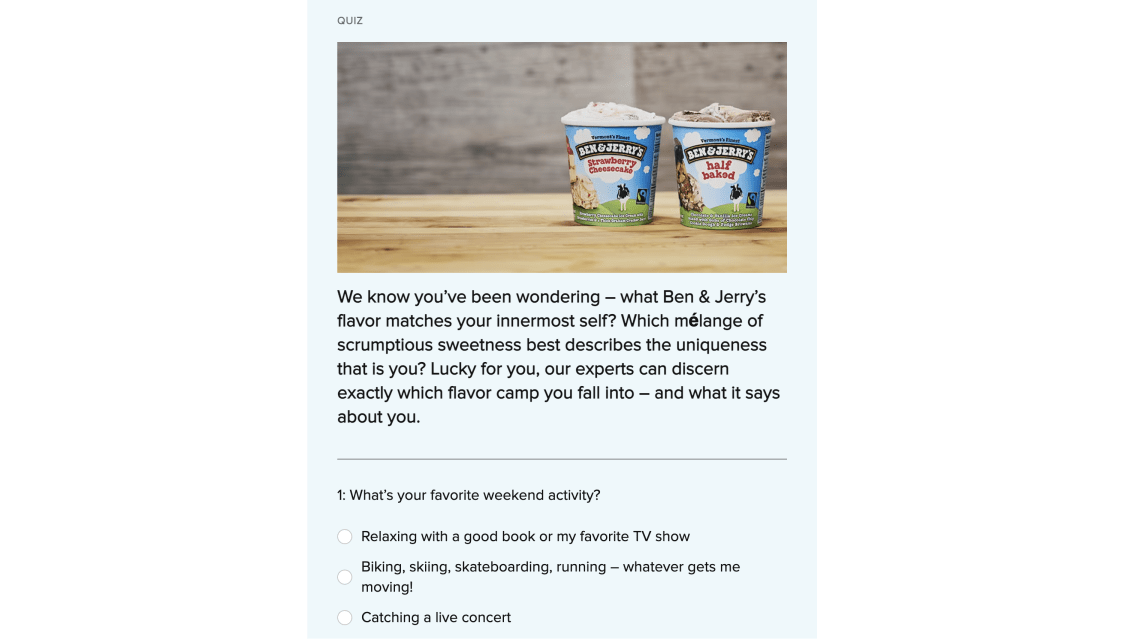
#12 Example
Another fun quiz to take, the Ben and Jerry’s Ice Cream Flavor Quiz instantly makes you want to eat a bowl. What is also does right:
- The questions are easy to answer.
- The results are surprisingly accurate.
- It puts you in a good mood.
The main reason this quiz has made it onto this list is the incredible aptness of the results. They don’t tell you what flavor you like to eat but reveal what kind of person you are. It has been tested in a group of ten people, and it got all of them right! (In case you were wondering, I’m a Strawberry Cheesecake.)
The Domino’s which pizza suits you quiz

#13 Example
Finally, we have the Domino’s pizza quiz, which does one thing right: it helps you choose which pizza to eat tonight! As all of these examples show you, this is what you need to do to create the perfect lead-generation quiz:
- Tie it directly to your product.
- Write and design it well: make it fun, simple, and reflective of your personality.
- Put leads in a converting mood.
- Personalize it as much as possible.
- Make it easy to share on social media.
- Don’t gate it, but provide a signup option.
- Provide real value, insight, or useful information.
- Understand your audience and their pain points and needs.
- Ensure the results make sense.
- Use the results to optimize future touchpoints.
How to create online quizzes for your business
If you are ready to start creating your own quiz, we have a treat in store. You don’t have to spend hours creating a quiz from scratch. You can use one of our quiz templates to get started, completely free! There really is no excuse not to create your unique quiz by the end of the day.
Free quiz templates!
Here at forms.app, we have loads of wonderful quiz templates available for you, so you can literally make yours in a matter of minutes once you have all of your questions down.
If you would like to help your audience learn more about themselves, you can try our personality quiz template. There is also a general trivia quiz template, if that’s what you’d prefer, as well as hundreds of other interesting templates you can use to get started with lead generation.
In Closing
A lead generation quiz can help you boost engagement and user experience as well as personalize marketing and sales touchpoints. Remember that your main goal is to keep the quiz interesting and the information you provide honest, valuable, and relevant!
Sena is a content writer at forms.app. She likes to read and write articles on different topics. Sena also likes to learn about different cultures and travel. She likes to study and learn different languages. Her specialty is linguistics, surveys, survey questions, and sampling methods.
- The benefits of creating a quiz
- Idea #1: Use quiz results to personalize experiences
- Idea #2: Use quiz results to personalize further communication
- Idea #3: Use quiz results to personalize the product
- Idea #4: Help visitors learn something
- Idea #5: Make the headline the hero
- Idea #6: Share the results anyway
- Idea #7: Keep the results positive
- Idea #8: Make it look good
- 5 More examples to inspire your next quiz
- How to create online quizzes for your business
- In Closing
